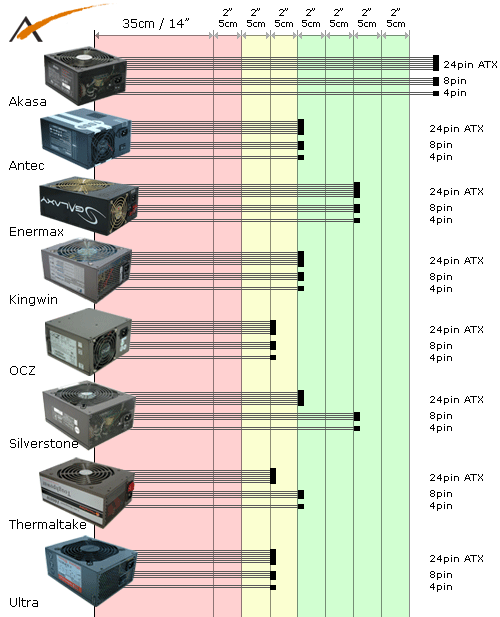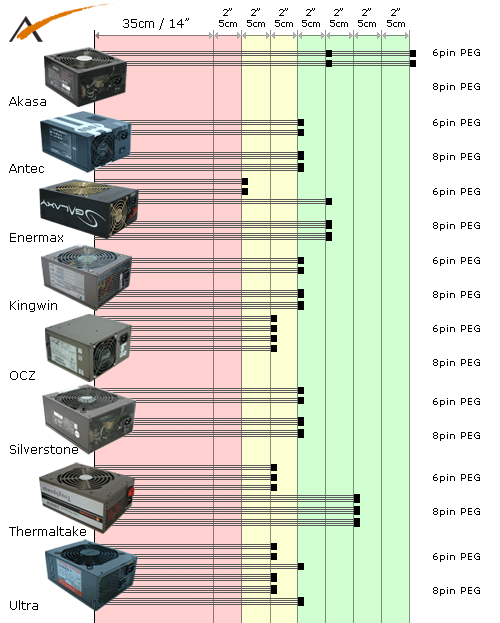Power Supply Roundup: Eight 1000W for the Extreme Users
by Christoph Katzer on December 11, 2007 9:30 PM EST- Posted in
- Cases/Cooling/PSUs
Product Comparison: Cable Lengths

When it comes to ATX cables lengths, we find different approaches from the manufacturers. As we can see, Akasa equips its PowerMax with 75cm cable harnesses - sufficient for even the largest cases. Next in line are Enermax and Silverstone with up to 60cm harnesses. The average length of 50cm is reached by Antec and Kingwin. Ultra, OCZ and Thermaltake power supplies only have 45 to 50cm harnesses on disposal. This seems quite short but it depends on the case you will use. For most cases, a 50cm harness will be more than enough, and in some cases shorter cables would even be desirable - that's why Silverstone also sells a short cable harness package (not tested or shown).

Having a 1000W power supply means you likely bought it to power up many hard disks, two or more high-end graphics cards, a quad-core processor (or perhaps dual socket octal-core) - perhaps all of these combined. Here we have different approaches from the manufacturers. Ultra and Thermaltake deliver the best choice of cables with their cable management, since they include six PEG harnesses and allow the users to select which ones are most useful. The downside is that you are only able to connect four at the same time, but who needs six PEG connectors? If you're moving to an all-SATA setup, it's also good to be able to ditch unnecessary Molex connectors.
Enermax has the best connectivity since the user will be able to connect up to five PEG connectors at the same time. With the Galaxy, you will have three 6-pin and two 8-pin PEG connectors available. Akasa has only four 6-pin connectors like the OCZ ProXStream but at least you can change two of the connectors to 8-pin PEG connectors. Antec and Silverstone will work with any dual graphics cards user with the two 6-pin and two 6/8-pin PEG connectors - or quad GPUs provided each GPU only needs a single PEG connector.










29 Comments
View All Comments
kuraegomon - Wednesday, December 12, 2007 - link
Except that you don't want to run your power supply at 80-100% of its capacity. You probably want to run at 50-70% of capacity when you do your build for several reasons:- expandabiliity (though hopefully future components will be MORE efficient, not less - can't count on it though, especially with graphics cards)
- component life. Any power supply will last longer if it's being run at a lower percentage of its rated capacity. It'll also run cooler, which means:
- less degradation. Over time power supplies lose capacity. A five year-old power supply can't meet the same current/wattage specs that it could when it was new. This process is accelerated by thermal conditions. The hotter the PS runs, the more quickly its peak capacity will degrade.
So, in my case, I have 2 x 8800 GTX's (overclocked), a Q6600 G0 (overclocked), 4 x 10K Raptors (RAID 0), 2 x 7200 Seagate 7200.10 (RAID 1), plus 4 GB of DDR2, and a 3Ware 9650SE 8-port hardware RAID card. My system draws over 500 Watts at IDLE, Over 650 Watts at heavy load, and I'm only running a 25% overclock on my CPU, and no overclock on my memory. How much expansion room would even a quality 650-750 W power supply give me, and how reliable will it be under similar loads in 5 years?
That's why I have a Thermaltake Toughpower 1200. Efficiency runs 80-87%, and I'm running it at no more than 60 % capacity. Good recipe for maximizing the life of the expensive power supply, and even more so the even more expensive components it powers. My advice? Figure out the total load draw of the following components, then make sure that number is less than 70% of the max capacity of whatever quality power supply you purchase:
- Graphics card
- Hard drives - DON'T forget about access draw and spin-up. HD's draw significantly more power on spinup. Multiplied when you're running RAID arrays, even if you configure staggered spinup, you still will have multiple drives accessing at once. Relatively small but it adds up
- CPU, especially quad-cores
- Memory, especially more than 2 GB. Many people overlook this factor when calculating potential power draw, but 4 GB of fast DDR2 will pull significant wattage (more than 1 or 2 hard drives, in most cases). Luckily DDR3 consumes less power. Hopefully graphics cards stick to this trend as well!
The short version: there absolutely are people who need and should buy 1000+ Watt PS's, who don't run 16 drives, 4 video cards, etc. Most people don't, but equally, many people underestimate the amount (and quality!) of PS they need.
kuraegomon - Wednesday, December 12, 2007 - link
Correction: over 400 W at idle. Though closer to 500 than 400Christoph Katzer - Wednesday, December 12, 2007 - link
Coming from next year on.regster - Tuesday, December 11, 2007 - link
These test results for Product Comparison: Voltage Ripple/Noise are flawed in as the setting for the different pictures are set to different voltages from different manufactures. This implies that one is nosier than another when in fact they are not.People are going to be making purchasing decisions on these results and we can only think you are totally incompetent or that you are being paid off by some manufactures to make there product look better.
Christoph Katzer - Wednesday, December 12, 2007 - link
That's why I write the results below in the text. There aren't any misunderstandings since a user who can't read these graphs will not make assumptions and a buying decision with it.madgonad - Tuesday, December 11, 2007 - link
I still would like to know what kind of results inexpensive power supplies turn in. I know everyone likes to dream about dual-quadcores and 4x Crossfire, but that is a market measured in the low thousands. Choosing a power supply for home builders is often a place where some corners are cut. It would be nice to know which choices don't really cut those corners.sprockkets - Tuesday, December 11, 2007 - link
So much for hoping you would test any FSP units this time around.Christoph Katzer - Wednesday, December 12, 2007 - link
Send me one I test it. I know FSP for quite some time already but unfortunately they haven't been able to send me some pieces in until now...AMDJunkie - Tuesday, December 11, 2007 - link
While testing and posting a review of 8 seperate 1KW power supply units is an admirable job, reading it felt of the first draft quality. There is nothing glaringly wrong, but it seems that some points are mentioned to never be addressed later on (you say the Ultra X3 is the older power supply of the lineup [and you might want to qualify that statement with dates], adding it in to see whether newer power supplies perform better, or are just new. Where is your conclusion on this point?) or simply having too many charts and not enough analyses - there are only two paragraphs that sum up 8 units in the ripple test?Even if they are very similar performing and that no one could go wrong with either unit, do take the time to go out of your way to point out what minor differences there are and give your opinion as well as your facts. The conclusion is conspicuously lacking in this regard. Otherwise, a very informative review. If only I hadn't already purchased an 800W unit!